
Extreme Traumatic Fear
Trauma Sufferers Can Sometimes Experience a Profound Extreme Form of Fear that can Incapacitate or Worse
Primary Category: Scam Victim Recovery Psychology
Author:
• Tim McGuinness, Ph.D., DFin, MCPO, MAnth – Anthropologist, Scientist, Polymath, Director of the Society of Citizens Against Relationship Scams Inc.
Author Biographies Below
About This Article
Extreme traumatic fear is a powerful survival response that can overwhelm your body and mind long after danger has passed. You may feel a racing heart, rapid breathing, dizziness, or dissociation as the amygdala and the HPA axis flood you with stress hormones. For some people, this state persists and fuels PTSD symptoms such as intrusions, avoidance, hypervigilance, and sleep disruption. In rare but real cases, intense fear can contribute to medical crises like stress-induced cardiomyopathy, dangerous heart rhythms, or collapse driven by nocebo beliefs and cultural terror. Crowd panic and poor decisions under stress can also cause harm. You can lower risk by using grounded skills that calm the nervous system, including paced breathing, sensory grounding, progressive muscle relaxation, cold-water face cooling, gentle movement, and clear self-talk. Pair these with a safety plan, social support, and timely medical or therapeutic care. If you feel unsafe or in crisis, call 911 or your local emergency number.
Note: This article is intended for informational purposes and does not replace professional medical advice. If you are experiencing distress, please consult a qualified mental health professional.

Trauma Sufferers Can Sometimes Experience a Profound Extreme Form of Fear that can Incapacitate or Worse
Author’s Note
This article about Extreme Traumatic Fear is a bit more technical in nature. It was written this way to make it a bit easier to read without overwhelming. It is a complex topic and one that may concern many, but if you are reading this, you are probably less likely to experience it, since you are already taking steps to help you manage your trauma.
If you are feeling afraid, please call 988 (or your local crisis hotline), and their counselors can help you through the event.
What is Extreme Traumatic Fear
Extreme Traumatic Fear refers to an intense, overwhelming fear response triggered by a traumatic event that threatens one’s safety, survival, or psychological well-being, often exceeding normal fear in duration, intensity, or impact.
It is characterized by acute activation of the body’s fight-or-flight response, driven by the amygdala and hypothalamic-pituitary-adrenal (HPA) axis, leading to physiological changes (e.g., elevated heart rate, cortisol spikes) and psychological distress (e.g., panic, dissociation).
This fear is a hallmark of psychological trauma, where the event, such as violence, abuse, or a life-threatening situation, overwhelms coping mechanisms, imprinting a lasting sense of danger. It can manifest in disorders like PTSD, marked by intrusive memories, hypervigilance, and avoidance, as the brain struggles to extinguish the fear response. For example, scam victims may experience extreme fear after betrayal, fearing revictimization, which can amplify trauma symptoms. Unlike typical fear, extreme traumatic fear disrupts daily functioning and may persist long after the threat, often requiring intervention like CBT to recalibrate.
How Prevalent is Traumatic Fear
Extreme fear is a core component of psychological trauma, often manifesting as an immediate response to traumatic events and persisting in disorders like posttraumatic stress disorder (PTSD), where it contributes to symptoms such as intrusions, avoidance, hyperarousal, and altered physiological reactivity.
Globally, approximately 70% of the population has been exposed to at least one traumatic event, which can trigger intense fear and subsequent mental health issues. The lifetime prevalence of PTSD, a key trauma-related disorder involving excessive fear, is estimated at 3.9% worldwide, rising to 5.6% among those exposed to trauma and over 15.3% in populations affected by violent conflict or sexual violence, which also includes betrayal trauma from certain scams, fraud, and cybercrimes. In the United States, PTSD lifetime risk is higher at 8.7%, with elevated rates among veterans, rape survivors, and emergency personnel. While most trauma-exposed individuals recover without long-term impairment, a smaller subset develops persistent fear-driven psychopathology, influenced by factors like fear conditioning, long-term amygdala hyperresponsivity, and extinction deficits. Prevalence is higher in vulnerable groups, such as those with co-occurring mental disorders or in conflict zones, underscoring the need for targeted interventions.
The Supernatural Power of Fear
Fear is a primal emotion, hardwired into our biology to ensure survival, but its overwhelming force can sometimes turn destructive, causing significant physical and psychological harm or, in extreme cases, contributing to death. While often viewed as a psychological response, fear’s “supernatural” power lies in its ability to hijack the body’s physiological systems, trigger catastrophic reactions, and amplify harm through cultural or social phenomena like mass hysteria. Fear can cause harm or death, supported by scientific evidence, historical cases, and psychological mechanisms.
Physiological Mechanisms of Fear-Induced Harm
Fear activates the autonomic nervous system, particularly the sympathetic branch, triggering the fight-or-flight response. This floods the body with stress hormones like adrenaline and cortisol, increasing heart rate, blood pressure, and respiration. While adaptive in short bursts, intense or prolonged fear can push these systems to dangerous extremes:
-
- Cardiovascular Collapse: Extreme fear can cause stress-induced cardiomyopathy (Takotsubo syndrome), where the heart temporarily weakens due to massive adrenaline surges. A 2015 study in the New England Journal of Medicine documented cases where acute emotional stress, including fear, led to heart failure-like symptoms, occasionally fatal in vulnerable individuals (e.g., those with pre-existing heart conditions). Sudden fear, like from a jump scare or trauma, can also trigger arrhythmias, leading to sudden cardiac death in rare cases. For example, a 2017 Journal of the American College of Cardiology study noted that acute emotional stress could precipitate ventricular fibrillation in susceptible hearts.
- Voodoo Death (Psychogenic Death): Anthropological studies, like Walter Cannon’s 1942 paper “Voodoo Death” in American Anthropologist, describe cases where intense fear, often tied to cultural beliefs in curses or supernatural punishment, led to death without physical cause. Victims, convinced they were doomed (e.g., by a shaman’s curse), experienced extreme stress, leading to autonomic overload, hypovolemic shock, or organ failure. Modern neuroscience suggests this involves the vagus nerve overactivation, causing a drastic drop in heart rate and blood pressure, potentially fatal. A 2018 Psychosomatic Medicine review linked such cases to nocebo effects, where belief in harm amplifies physiological damage.
- Immune Suppression and Chronic Harm: Prolonged fear, as in chronic anxiety or PTSD, elevates cortisol, weakening the immune system. A 2004 Psychological Bulletin meta-analysis found that chronic stress increases susceptibility to infections and delays wound healing, indirectly raising mortality risks in vulnerable populations (e.g., the elderly). For example, fear-driven stress in pregnant women can lead to miscarriage or preterm birth, as noted in studies on stress hormones disrupting placental function (e.g., 2019 American Journal of Obstetrics and Gynecology).
Psychological and Behavioral Harm
Fear’s psychological grip can cause harm by altering behavior or mental health, sometimes with lethal consequences:
-
- Panic-Induced Accidents: Intense fear can impair decision-making, leading to fatal errors. Historical examples include stampedes during emergencies, like the 2003 Station nightclub fire, where fear-driven panic caused 100 deaths as people rushed exits. A 2010 Safety Science study analyzed crowd disasters, noting that fear-induced hyperarousal overrides rational escape strategies, causing crushing injuries or suffocation.
- Mental Health Deterioration: Fear can exacerbate conditions like anxiety or depression, leading to self-harm or suicide. A 2020 The Lancet Psychiatry study linked fear of social threats (e.g., stigma, betrayal) to increased suicide risk in trauma survivors, particularly those with PTSD. For scam victims, as discussed earlier, fear of financial ruin or revictimization can deepen despair, amplifying suicidal ideation.
- Mass Hysteria and Social Harm: Fear can spread collectively, causing societal damage. The 1692 Salem Witch Trials, driven by fear of witchcraft, led to 20 executions and widespread trauma, as documented in historical analyses like Salem Possessed (1974). Modern equivalents, like 2020’s COVID-19 panic buying, caused shortages and violence, with a Nature Human Behaviour study noting fear-driven hoarding disrupted supply chains, harming vulnerable communities.
Fear and Supernatural Contexts
The term “supernatural power” often evokes cultural or mystical beliefs, amplifying fear’s impact. In contexts like voodoo death, fear’s lethality stems from a belief in supernatural forces (e.g., curses), which triggers a nocebo effect, where expecting harm causes it. A 2015 Brain, Behavior, and Immunity study found that nocebo effects can increase inflammation and pain perception, potentially exacerbating conditions to fatal levels in extreme cases. Similarly, fear of demonic possession or paranormal activity can induce panic attacks or psychosis-like symptoms, as seen in case studies of religious trauma (e.g., 2019 Journal of Religion and Health). These effects are not “supernatural” but reflect the brain’s ability to translate belief into physiological havoc.
Mitigating Fear’s Harm
Understanding fear’s power is key to countering it:
-
- Cognitive Strategies: Mindfulness and cognitive-behavioral therapy (CBT) reduce fear’s intensity by reframing threats. A 2018 Journal of Anxiety Disorders study showed CBT lowered cortisol in panic disorder patients.
- Physiological Interventions: Beta-blockers or vagal nerve stimulation can stabilize heart rate during acute fear, as per a 2021 Frontiers in Neuroscience study.
- Social Support: Community buffers fear’s spread, as seen in trauma recovery programs reducing PTSD symptoms (2020 Journal of Traumatic Stress).
Fear’s “supernatural” power lies in its ability to overwhelm body and mind, turning a survival mechanism into a destructive force. Through cardiovascular strain, psychogenic death, behavioral errors, or societal chaos, fear can harm or kill, especially when amplified by cultural beliefs or extreme stress. Scam victims, trauma survivors, and those in high-stress environments are particularly vulnerable, as fear compounds existing wounds. By understanding its mechanisms, via science, not mysticism, we can mitigate its grip, using tools like therapy, medical intervention, and community to reclaim control. Fear may feel otherworldly, but its dangers are very real and, crucially, manageable.
Can Fear Cause Death or Serious Injury?
Yes, there are documented cases where extreme fear or fright has contributed to death, though such events are rare and typically involve underlying vulnerabilities or extreme circumstances.
These cases often fall under mechanisms like stress-induced cardiomyopathy (Takotsubo syndrome), sudden cardiac death due to arrhythmias, or psychogenic death (sometimes called “voodoo death”), where intense fear triggers fatal physiological responses. Below, I outline key examples and mechanisms, drawing on scientific literature and historical accounts, to illustrate how fear can be lethal.
Mechanisms of Fear-Induced Death
Fear triggers the fight-or-flight response, releasing adrenaline and cortisol, which spike heart rate, blood pressure, and respiration. In extreme cases, this can overwhelm the body:
-
- Stress-Induced Cardiomyopathy (Takotsubo Syndrome): Severe fear can cause a surge of catecholamines (e.g., adrenaline), temporarily weakening the heart muscle, mimicking a heart attack. A 2015 study in the New England Journal of Medicine noted that emotional stress, including intense fear, can trigger this condition, which is fatal in about 1–5% of cases, especially in those with pre-existing heart issues.
- Sudden Cardiac Death: Acute fear can induce arrhythmias (irregular heartbeats), like ventricular fibrillation, leading to sudden death. A 2017 Journal of the American College of Cardiology study linked acute emotional stress to fatal arrhythmias in susceptible individuals.
- Voodoo Death (Psychogenic Death): Extreme fear, often tied to cultural beliefs (e.g., curses), can cause autonomic collapse. Walter Cannon’s 1942 American Anthropologist paper described cases where individuals, believing they were doomed by a shaman’s curse, died within hours due to vagal nerve overactivation, causing a drastic drop in heart rate and blood pressure. A 2018 Psychosomatic Medicine review tied this to nocebo effects, where belief in harm amplifies physiological damage.
- Neurological Overload: Intense fear can trigger seizures or stroke-like events in rare cases, particularly in those with epilepsy or vascular weaknesses. A 2019 Neurology case report described a patient with a fear-induced seizure leading to fatal complications.
Contextual Notes
-
- Vulnerability Factors: Most fear-related deaths involve predisposing conditions (e.g., undiagnosed heart issues, epilepsy) or extreme circumstances (e.g., cultural beliefs, life-threatening situations). Healthy individuals rarely die from fear alone, but the risk rises with age, stress, or comorbidities.
- Scam Victims Connection: As discussed in prior contexts, scam victims, particularly the elderly, face heightened fear (e.g., of financial ruin or revictimization via fake IC3 sites). This can elevate cortisol and blood pressure, increasing heart attack risk in those with underlying conditions, as noted in a 2020 Journal of Traumatic Stress study on trauma and cardiovascular health.
- Cultural Amplification: Fear’s lethality is amplified in cultures with strong supernatural beliefs, where nocebo effects (expecting harm) can trigger fatal physiological responses. This was evident in voodoo death cases and Hmong refugee deaths.
Mitigating the Risk
-
- Medical Intervention: Prompt treatment (e.g., beta-blockers for arrhythmias, NAC for overdoses as in pregnancy cases) can prevent fatal outcomes.
- Psychological Tools: Cognitive-behavioral therapy (CBT) and mindfulness reduce fear’s intensity, lowering cortisol and heart strain, per a 2018 Journal of Anxiety Disorders study.
- Education: Awareness of fear’s physiological effects can reduce panic escalation, as seen in crowd safety training post-Mecca.
While rare, death from fear or fright is real, occurring through mechanisms like cardiac overload, vagal collapse, or panic-driven accidents. Cases range from cultural phenomena (voodoo death, Hmong deaths) to modern incidents (haunted house collapses, home invasions). Vulnerable populations, like scam victims or those with heart conditions, face higher risks. Understanding these mechanisms empowers prevention through medical, psychological, and social strategies, ensuring fear doesn’t turn deadly.
Note: if you feel as though you are experiencing a severe panic attack or think you might be experiencing a cardiac event, call 911 (or your local emergency number) immediately. Do not wait, and do not be embarrassed; this is one of those cases where safety is all that matters.
Controlling Overwhelming Fear
When experiencing an overwhelming fear or panic attack, individuals can employ several evidence-based strategies to calm their mind and body. These techniques focus on regulating the autonomic nervous system, reducing the intensity of the fight-or-flight response, and grounding oneself in the present moment. Below are practical, actionable steps, supported by psychological and physiological research, to manage acute fear or panic effectively. These can be used alone or in combination, depending on what feels accessible during the moment.
Immediate Strategies to Calm a Panic Attack or Overwhelming Fear
-
- Deep Breathing (Diaphragmatic Breathing)
- How: Inhale slowly through your nose for 4 seconds, hold for 4 seconds, and exhale through your mouth for 6–8 seconds, focusing on your belly expanding. Repeat 5–10 times.
- Why: Slow, controlled breathing reduces heart rate and cortisol levels, countering hyperventilation common in panic attacks. A 2018 Journal of Anxiety Disorders study found that diaphragmatic breathing lowers physiological arousal in panic disorder patients.
- Tip: Place a hand on your stomach to ensure deep, not shallow, breaths. Try the “box breathing” variation (4-4-4-4 rhythm) if it feels more structured.
- Grounding Techniques (5-4-3-2-1 Method)
- How: Identify 5 things you see, 4 things you can touch, 3 things you hear, 2 things you smell, and 1 thing you taste. Describe them vividly in your mind or aloud.
- Why: This sensory exercise anchors you in the present, interrupting racing thoughts and reducing amygdala activation. A 2020 Journal of Traumatic Stress study noted that grounding techniques help manage acute PTSD symptoms, which overlap with panic.
- Tip: If sensory overload is an issue, focus only on touch (e.g., feel the texture of your clothing) to avoid overstimulation.
- Progressive Muscle Relaxation (PMR)
- How: Tense and release muscle groups one at a time (e.g., fists, shoulders, legs) for 5–10 seconds each, moving from feet to head. Focus on the release sensation.
- Why: PMR reduces physical tension and signals safety to the nervous system. A 2019 Frontiers in Psychology study showed PMR decreases anxiety symptoms by lowering sympathetic nervous system activity.
- Tip: Start with smaller muscle groups if full-body tensing feels overwhelming.
- Cold Exposure
- How: Splash cold water on your face, hold an ice pack to your wrists, or sip ice-cold water slowly. Alternatively, dunk your face in a bowl of cold water for 10–20 seconds (diving reflex).
- Why: Cold stimuli activate the parasympathetic nervous system, slowing heart rate and calming panic. A 2021 Frontiers in Neuroscience study highlighted the diving reflex’s role in reducing acute stress responses.
- Tip: Keep a reusable ice pack handy for quick access during panic.
- Cognitive Reframing (Self-Talk) – Name It, Don’t Shame It
- How: Silently or aloud, repeat calming phrases like, “This is temporary, I am safe,” or “My body is reacting, but I’m not in danger.” Name the panic: “This is a panic attack, not a heart attack.”
- Why: Labeling and reframing thoughts reduce amygdala-driven fear spirals. A 2017 Cognitive Therapy and Research study showed cognitive restructuring lowers anxiety by altering threat perception.
- Tip: Write a go-to phrase on your phone or a card to read during an attack.
- Body Movement (Light Activity)
- How: Take slow steps, shake out your hands, or do gentle stretches for 1–2 minutes. Avoid intense exercise, which can mimic panic symptoms.
- Why: Movement dissipates excess adrenaline and promotes vagal tone. A 2020 Journal of Affective Disorders study found light physical activity reduces acute anxiety symptoms.
- Tip: Focus on rhythmic movements, like pacing in a small circle, to stay grounded.
- Distraction Techniques
- How: Count backward from 100 by 7s, recite a poem, or focus on a neutral object (e.g., describe a nearby chair in detail).
- Why: Shifting attention from fear to a cognitive task reduces panic intensity. A 2016 Behavior Research and Therapy study showed distraction lowers acute anxiety by engaging the prefrontal cortex.
- Tip: Keep a simple puzzle or fidget toy nearby for quick distraction.
- Seek a Safe Presence
- How: If possible, call or sit with a trusted person, even briefly. Ask them to speak calmly or just stay present without trying to “fix” the panic.
- Why: Social connection activates oxytocin, calming the stress response. A 2020 Journal of Traumatic Stress study emphasized social support’s role in reducing trauma-related panic.
- Tip: Pre-identify a “safe person” and share a signal (e.g., “I’m panicking, just talk to me”) for emergencies.
- Deep Breathing (Diaphragmatic Breathing)
Additional Tips for Effective Management
-
- Prepare in Advance: Practice these techniques when calm to build familiarity. A 2019 Clinical Psychology Review found that proactive skill-building enhances panic control.
- Avoid Triggers Temporarily: If possible, step away from the fear source (e.g., a crowded room) to a quieter space to apply these methods.
- Post-Panic Care: After an attack, rest, hydrate, and avoid caffeine or alcohol, which can retrigger symptoms. Journaling about the experience can help process it.
- When to Seek Help: If panic attacks are frequent or debilitating, consult a doctor or therapist. Conditions like panic disorder or PTSD may require cognitive-behavioral therapy (CBT) or medication. A 2021 The Lancet Psychiatry study supports CBT as a first-line treatment.
Connection to Prior Contexts
For scam victims, as discussed earlier, fear of revictimization (e.g., via fake IC3 sites) or financial ruin can trigger panic attacks. These techniques are particularly relevant, as fear can exacerbate trauma-related symptoms, increasing risks like cardiovascular strain in vulnerable individuals. Similarly, pregnant women facing fear (e.g., from health concerns like acetaminophen overdose) can use these methods to reduce stress, which may otherwise risk miscarriage.
Overwhelming fear or panic attacks can be managed with accessible techniques like deep breathing, grounding, PMR, cold exposure, cognitive reframing, movement, distraction, and social support. These methods calm the body’s stress response, reducing the risk of harm from acute fear, as seen in cases of stress-induced cardiomyopathy or psychogenic death. Regular practice and professional support enhance their effectiveness, empowering individuals to regain control even in intense moments.

Glossary
- Acute stress response — A person may feel a sudden surge of energy, a racing heart, and fast breathing as the body prepares to face a threat. This reaction can help in real danger, but it also fires during scams or reminders of past harm. It settles faster when breathing slows, the senses ground in the present, and space is created before acting.
- Amygdala — This almond-shaped brain region detects threat and starts the fear response. When it stays overactive, a person feels jumpy, anxious, and easily triggered. It calms with clear feeling labels, slower breathing, and a safe connection.
- Arrhythmia — Intense fear can bring skipped beats or a fluttering heart, especially in vulnerable bodies. Most episodes pass, yet some rhythms are dangerous when underlying heart issues exist. Medical care for new or severe symptoms and steady calming skills reduce risk.
- Avoidance — People may pull away from places, people, or tasks that remind them of trauma or a scam. Avoidance brings short relief but keeps fear strong over time. Gradual, supported exposure helps fear fade and restores daily function.
- Box breathing — Inhaling, holding, exhaling, and holding again in equal counts, such as four-four-four-four, lowers arousal. The pattern steadies attention during spikes of panic. Daily practice builds a reflex that is available under pressure.
- Cardiovascular collapse — Extreme stress can dangerously impair heart function, particularly in those with medical vulnerabilities. Chest pain, fainting, or severe shortness of breath signal urgent risk. Immediate emergency care protects life and health.
- Cognitive reframing — Clear, factual self-talk reduces catastrophic thoughts. Replacing “I am in danger” with “I am having a fear surge, and it will pass” creates room for safer choices. The shift anchors behavior in the present rather than in worst-case stories.
- Dissociation — Overwhelming fear can produce detachment, numbness, or a sense of unreality. This protects against pain in the moment but disrupts memory and decisions. Sensory grounding and gentle movement help attention return to the body.
- Diving reflex (cold water) — Cooling the face with water or an ice pack can trigger a natural calming response. Heart rate slows and panic intensity drops within seconds. Keeping a cold pack handy offers quick relief during surges.
- Extinction learning — The brain learns that a cue no longer equals danger when it is faced safely and repeatedly. With practice, the alarm softens. Small, supported steps make updating easier for the nervous system.
- Fight-or-flight — Fast heartbeat, tense muscles, and sharpened senses prepare the body to run or confront a threat. This state is adaptive in emergencies, yet exhausting when it persists. Slow breathing, grounding, and supportive contact help it downshift.
- Grounding (5-4-3-2-1) — Naming five things seen, four touched, three heard, two smelled, and one tasted pulls attention to the present. This interrupts racing thoughts and lowers arousal. Short versions help when sensory input feels intense.
- HPA axis — This stress pathway links the brain and adrenal glands to release cortisol. Short bursts support coping, while chronic activation harms sleep, mood, and immunity. Regular routines for rest, meals, and movement protect this system.
- Hyperarousal — After trauma, a person can feel keyed up, quick to startle, and unable to settle. Sleep, focus, and patience often suffer. Predictable schedules, fewer stimulants, and brief calming breaks improve stability.
- Hyperventilation — Panic can cause fast, shallow breathing that leads to dizziness, tingling, and chest tightness. Slow, belly-centered breaths with longer exhales reverse the spiral. Breathing through the nose helps reduce pace naturally.
- Hypervigilance — Constant scanning for danger protects in a crisis, yet drains energy afterward. Small cues can trigger an outsized alarm. Safe people, familiar places, and routine help the system relax.
- Interoception — This is the sense of internal signals such as heartbeat, breath, and muscle tension. Trauma can make these signals feel frightening or hard to read. Nonjudgmental noticing turns them into useful guidance rather than fuel for panic.
- Intrusive memories — Sudden images, thoughts, or sensations linked to the event can feel as if the danger is happening now. They often arrive without warning and grab attention. Naming them, grounding, and returning to a chosen task reduce their pull.
- Memory reconsolidation — When a memory is recalled safely and paired with new information, its emotional weight can change. The memory remains, yet the sting softens. Supportive conditions make this updating more likely.
- Nocebo effect — Symptoms can become real and intense because harm is expected, especially under stress or strong belief. This does not make symptoms imaginary; it shows how expectation shapes physiology. Accurate information and steady reassurance reduce the impact.
- Panic attack — A sudden rush of fear can bring chest tightness, short breath, shaking, and dizziness. The surge peaks and passes even when it feels endless. Slow breathing, grounding, and a simple phrase such as “this will crest and ease” help it resolve.
- Parasympathetic nervous system — This calming branch slows heart rate, supports digestion, and restores balance. Fear turns it down, and recovery turns it back up. Paced breathing, gentle movement, and safe connection strengthen its influence.
- Polyvagal response — The nervous system shifts among social engagement, mobilization, and shutdown based on safety cues. Trauma can trap a person in high alert or collapse. Warm voice tones, eye contact, breath work, and predictable routines build safety.
- Posttraumatic stress disorder (PTSD) — Intrusions, avoidance, negative mood shifts, and hyperarousal can persist beyond a month after trauma. Daily life becomes harder to manage. Evaluation and evidence-based care support recovery.
- Progressive muscle relaxation (PMR) — Tensing and releasing muscle groups from feet to face reduces body tension. The release sends “safe” signals to the brain and eases physical discomfort. Pairing PMR with slow breathing deepens relief.
- Psychogenic death — In rare situations, extreme fear and belief can trigger a life-threatening collapse. This reflects the power of the stress response, not weakness of character. Calming skills, medical care when needed, and social support reduce risk.
- Safety plan — A brief written list for crises includes numbers to call, calming skills to use, and safe places to go. Keeping it visible makes action easier under stress. Sharing it with one trusted person adds support.
- Safety signals — Friendly voices, soft light, steady breath, and familiar objects teach the body that it is safe. These cues help downshift arousal during spikes. Building them into daily routines makes relief easier to find.
- Social support — Calm, nonjudgmental presence steadies breathing and lowers panic faster than going it alone. Even brief contact helps the system settle. Identifying one or two safe people and agreeing on a simple help signal adds protection.
- Stress-induced cardiomyopathy (Takotsubo) — A surge of stress hormones can temporarily weaken the heart and mimic a heart attack. Symptoms require urgent medical care. Long-term stress management supports recovery.
- Sudden cardiac death — Extreme fear can trigger fatal heart rhythms in susceptible individuals, though this is rare. New chest pain, fainting, or severe breathlessness is always an emergency. Prompt evaluation saves lives.
- Sympathetic nervous system — This activation pathway powers fight-or-flight, raising heart rate, blood pressure, and alertness. Short bursts help, while constant activation exhausts. Rest, breath, and routine restore balance.
- Trauma bond — Cycles of fear, relief, and hope can create a powerful attachment to someone who harms. The bond clouds judgment and delays leaving. Distance, support, and firm rules for money, access, and time break the pattern.
- Trigger — A cue, such as a voice tone, place, or message type, can spark a fast fear response. The body often reacts before conscious thought. Spotting common cues and rehearsing a grounding step reduces surprises.
- Urgency script — Pressured demands to act fast hijack judgment and drive mistakes. Offenders use this tactic to bypass verification and push transactions. A standing rule to pause, verify, and wait a day for money decisions blocks the rush.
- Verification pause — Independent checks through official channels come before action. This step reduces fear-driven errors and protects health and finances. Making it a rule, not a case-by-case choice, keeps decisions clear under stress.
Author Biographies
-/ 30 /-
What do you think about this?
Please share your thoughts in a comment below!
TABLE OF CONTENTS
- Trauma Sufferers Can Sometimes Experience a Profound Extreme Form of Fear that can Incapacitate or Worse
- Trauma Sufferers Can Sometimes Experience a Profound Extreme Form of Fear that can Incapacitate or Worse
- Author’s Note
- What is Extreme Traumatic Fear
- How Prevalent is Traumatic Fear
- The Supernatural Power of Fear
- Can Fear Cause Death or Serious Injury?
- Controlling Overwhelming Fear
- Glossary
CATEGORIES
![NavyLogo@4x-81[1] Extreme Traumatic Fear - 2025](https://scamsnow.com/wp-content/uploads/2025/04/NavyLogo@4x-811.png)
ARTICLE META
Important Information for New Scam Victims
- Please visit www.ScamVictimsSupport.org – a SCARS Website for New Scam Victims & Sextortion Victims.
- SCARS Institute now offers its free, safe, and private Scam Survivor’s Support Community at www.SCARScommunity.org – this is not on a social media platform, it is our own safe & secure platform created by the SCARS Institute especially for scam victims & survivors.
- SCARS Institute now offers a free recovery learning program at www.SCARSeducation.org.
- Please visit www.ScamPsychology.org – to more fully understand the psychological concepts involved in scams and scam victim recovery.
If you are looking for local trauma counselors, please visit counseling.AgainstScams.org
If you need to speak with someone now, you can dial 988 or find phone numbers for crisis hotlines all around the world here: www.opencounseling.com/suicide-hotlines
Statement About Victim Blaming
Some of our articles discuss various aspects of victims. This is both about better understanding victims (the science of victimology) and their behaviors and psychology. This helps us to educate victims/survivors about why these crimes happened and not to blame themselves, better develop recovery programs, and help victims avoid scams in the future. At times, this may sound like blaming the victim, but it does not blame scam victims; we are simply explaining the hows and whys of the experience victims have.
These articles, about the Psychology of Scams or Victim Psychology – meaning that all humans have psychological or cognitive characteristics in common that can either be exploited or work against us – help us all to understand the unique challenges victims face before, during, and after scams, fraud, or cybercrimes. These sometimes talk about some of the vulnerabilities the scammers exploit. Victims rarely have control of them or are even aware of them, until something like a scam happens, and then they can learn how their mind works and how to overcome these mechanisms.
Articles like these help victims and others understand these processes and how to help prevent them from being exploited again or to help them recover more easily by understanding their post-scam behaviors. Learn more about the Psychology of Scams at www.ScamPsychology.org
SCARS INSTITUTE RESOURCES:
If You Have Been Victimized By A Scam Or Cybercrime
♦ If you are a victim of scams, go to www.ScamVictimsSupport.org for real knowledge and help
♦ SCARS Institute now offers its free, safe, and private Scam Survivor’s Support Community at www.SCARScommunity.org/register – this is not on a social media platform, it is our own safe & secure platform created by the SCARS Institute especially for scam victims & survivors.
♦ Enroll in SCARS Scam Survivor’s School now at www.SCARSeducation.org
♦ To report criminals, visit https://reporting.AgainstScams.org – we will NEVER give your data to money recovery companies like some do!
♦ Follow us and find our podcasts, webinars, and helpful videos on YouTube: https://www.youtube.com/@RomancescamsNowcom
♦ Learn about the Psychology of Scams at www.ScamPsychology.org
♦ Dig deeper into the reality of scams, fraud, and cybercrime at www.ScamsNOW.com and www.RomanceScamsNOW.com
♦ Scam Survivor’s Stories: www.ScamSurvivorStories.org
♦ For Scam Victim Advocates visit www.ScamVictimsAdvocates.org
♦ See more scammer photos on www.ScammerPhotos.com
You can also find the SCARS Institute’s knowledge and information on Facebook, Instagram, X, LinkedIn, and TruthSocial
Psychology Disclaimer:
All articles about psychology and the human brain on this website are for information & education only
The information provided in this and other SCARS articles are intended for educational and self-help purposes only and should not be construed as a substitute for professional therapy or counseling.
Note about Mindfulness: Mindfulness practices have the potential to create psychological distress for some individuals. Please consult a mental health professional or experienced meditation instructor for guidance should you encounter difficulties.
While any self-help techniques outlined herein may be beneficial for scam victims seeking to recover from their experience and move towards recovery, it is important to consult with a qualified mental health professional before initiating any course of action. Each individual’s experience and needs are unique, and what works for one person may not be suitable for another.
Additionally, any approach may not be appropriate for individuals with certain pre-existing mental health conditions or trauma histories. It is advisable to seek guidance from a licensed therapist or counselor who can provide personalized support, guidance, and treatment tailored to your specific needs.
If you are experiencing significant distress or emotional difficulties related to a scam or other traumatic event, please consult your doctor or mental health provider for appropriate care and support.
Also read our SCARS Institute Statement about Professional Care for Scam Victims – click here
If you are in crisis, feeling desperate, or in despair, please call 988 or your local crisis hotline – international numbers here.
More ScamsNOW.com Articles
A Question of Trust
At the SCARS Institute, we invite you to do your own research on the topics we speak about and publish. Our team investigates the subject being discussed, especially when it comes to understanding the scam victims-survivors’ experience. You can do Google searches, but in many cases, you will have to wade through scientific papers and studies. However, remember that biases and perspectives matter and influence the outcome. Regardless, we encourage you to explore these topics as thoroughly as you can for your own awareness.




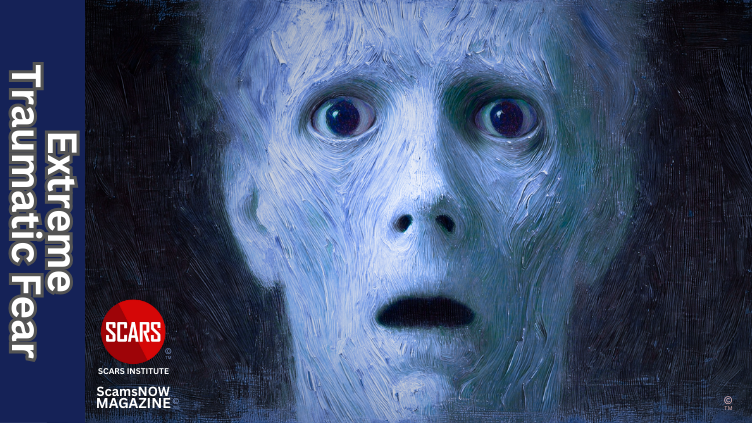
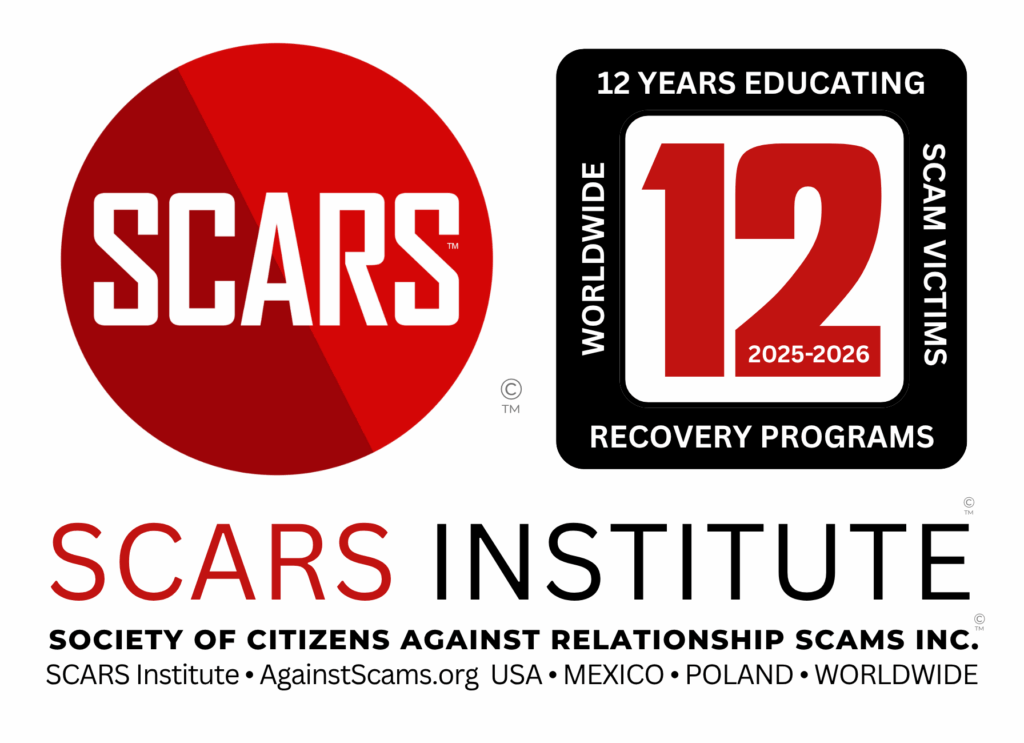






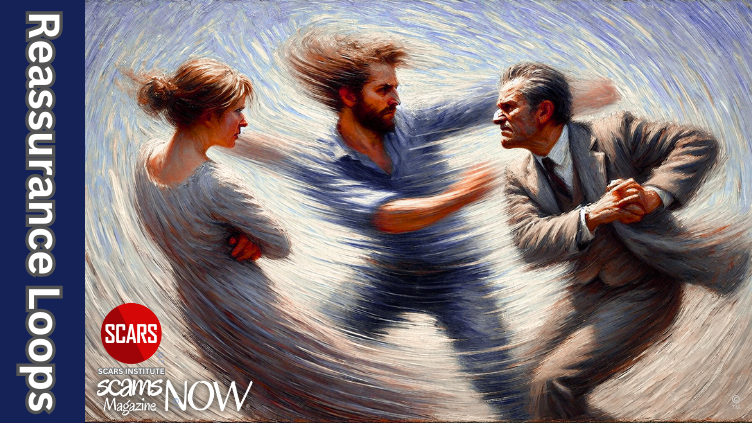






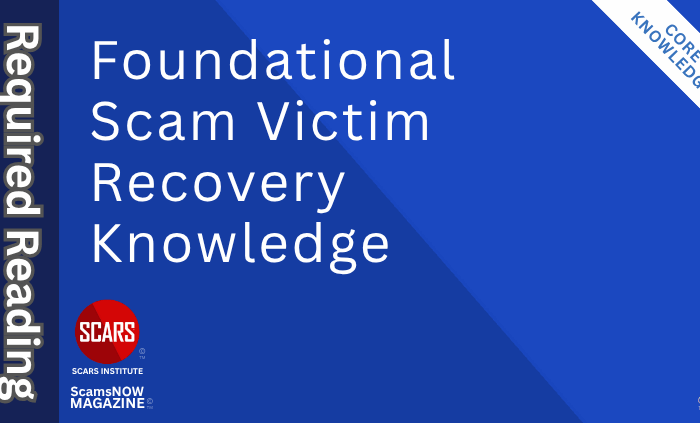

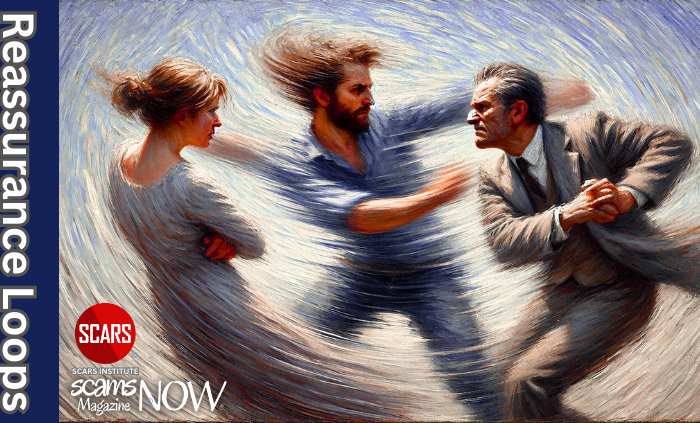


![scars-institute[1] Extreme Traumatic Fear - 2025](https://scamsnow.com/wp-content/uploads/2025/04/scars-institute1.png)

![niprc1.png1_-150×1501-1[1] Extreme Traumatic Fear - 2025](https://scamsnow.com/wp-content/uploads/2025/04/niprc1.png1_-150x1501-11.webp)
